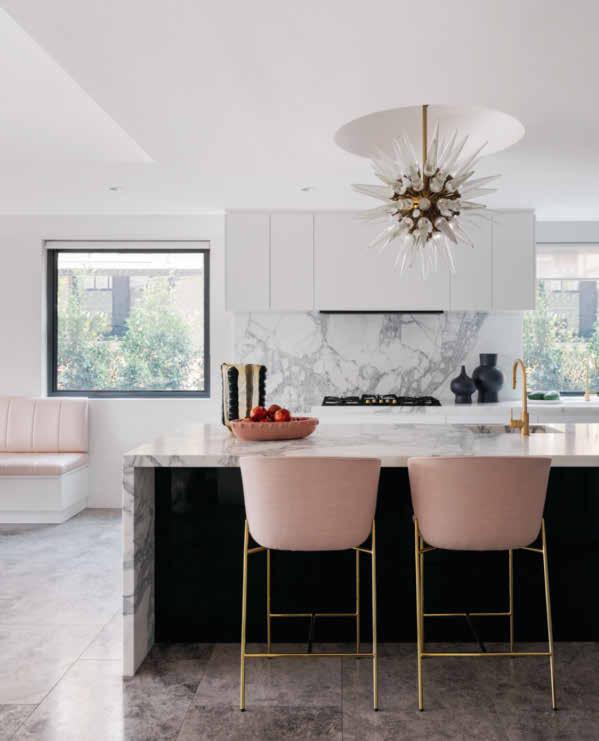
4 minute read
Interiors
By ELIZABETH CLARKE
Design words of 2022
With the past couple of years seeing us spend more time at home, our desire for spaces that cocoon, comfort and delight has become apparent. The pandemic has also had a significant effect on design trends, particularly when it comes to the look and feel of our homes. We asked five designers to unpack the design words that will define the coming year and the effects they’ll have on our homes.
Whimsy
Craving a luxe-feeling home that makes you smile? Cheeky inspiration, bold forms, and supercharged prints are some of the ways to inject a sense of the unexpected into the home.
“Drab ain’t going to lift your spirits,” Yasmine Saleh Ghoniem from YSG Studio says. “We’ve been cooped up and, despite being free again, collectively acknowledge the importance of transforming our homes into sanctuaries.”
Creating playful and unpretentious spaces is as simple as using lavish prints, sensual curves and ceilings and walls in expressive shades.
“I’m pretty bold when it comes to incorporating prints and unconventional colour selections,” she says. “Unexpected textural pairings and natural materials ... are my go-to’s.”
Customise
In a world of mass production, it’s no surprise there is growing demand for customised objects and spaces. From walk-in wardrobes to outdoor kitchens, made-to-measure can hold significant meaning.
“Today, when the world feels smaller through the ease of travel, technology and mass production, people feel a need to have something artisanal and unique,” designer Nina Maya says.
She says working with the right collaborators is key to achieving a custom vision.
“It’s special to have a design tailored to your needs and desires,” Maya says. “And it takes trusted and talented artisans to turn them into a reality. It can take a village to bring customised design to life.”
Plaster
Beautifully textural, plaster is the antithesis of plain plasterboard walls. It gives walls depth, movement and earthiness, and it’s particularly popular with designers embracing a romantic notion of home.
“Plaster has a feeling of age, authenticity and individuality,” says designer Sonia Simpfendorfer from Nexus Designs. “It subtly references the past and brings a sense of graceful ageing.
“Because polished plaster is shiny and hard, the right lighting adds layers of mood and appreciation,” she says. “Every application is unique, so the final results have variability. It’s the main reason plaster is so highly prized.”
FELIX FOREST
Transparency
“We see the impact of the climate crisis every day,” Sans Arc’s Matiya Marovich says. “The building industry contributes significantly to emissions, and we [can] impact this through design.”
Critical change requires transparency, which reassures consumers that they are making the right building decisions for the planet.
“Sustainability as a ‘company value’ is commonplace, but people see through the spin and are looking for good practice in design,” she says. “If the most affordable, beautiful and accessible option was the most environmentally friendly, then consumers would go that way every time.”
Key to achieving transparency includes drawing from ancient practices, using eco-friendly materials, and avoiding materials with large carbon footprints.
Interior design by Nina Maya.
Vibrance
A craving for positive energy is top priority for many of us now, says designer Kim Pearson: “Vibrance is an essential component of the human condition. It’s the things you see, touch, and handle that evoke good feelings, lift spirits and spark joy.”
Colour has the power to transform any space into a happy and uplifting environment.
“Explore the tones and shades of a single colour, like blue and its varying lighter and darker shades,” Pearson suggests. “Or look to nature for inspiration – she rarely gets it wrong. Have confidence in yourself and what you want from your space.”
Harnessing vibrance doesn’t require a heavy hand. A light peppering of colour can be the catalyst for significant shifts in mood and ambience.
Leaders in Educational Excellence

Victoria’s First IB World School
Forty years ago St Leonard’s College became the first Victorian school to offer the International Baccalaureate Diploma Programme (IBDP) as an additional pathway to tertiary education.
The IBDP’s internationally focused syllabus and rigorous assessment make it the tertiary entrance qualification most respected and widely recognised by the world’s leading universities. Our students benefit from highly qualified staff teaching across both the VCE and IBDP, helping them to attain the most prestigious scholarships at the leading universities in Australia and overseas.
The St Leonard’s College IBDP Class of 2021 achieved:
• A median ATAR of 97.90
• 2 Perfect ATARs of 99.95 • 89% of students achieved an ATAR of 95 or above • 94% of students achieved an ATAR of 90 or above • 100% of students achieved an ATAR of 80 or above
In addition to the year 11 and 12 IB Diploma Programme, our St Leonard’s College Junior School offers the International Baccalaureate Primary Years Programme (IB PYP), a curriculum framework expertly designed for children aged 3 to 12. The IB PYP focuses on international-mindedness and the development of strong personal values. It fosters academic, social and emotional growth and values independence, initiative and self-motivation, encouraging every student to take responsibility for their learning.






